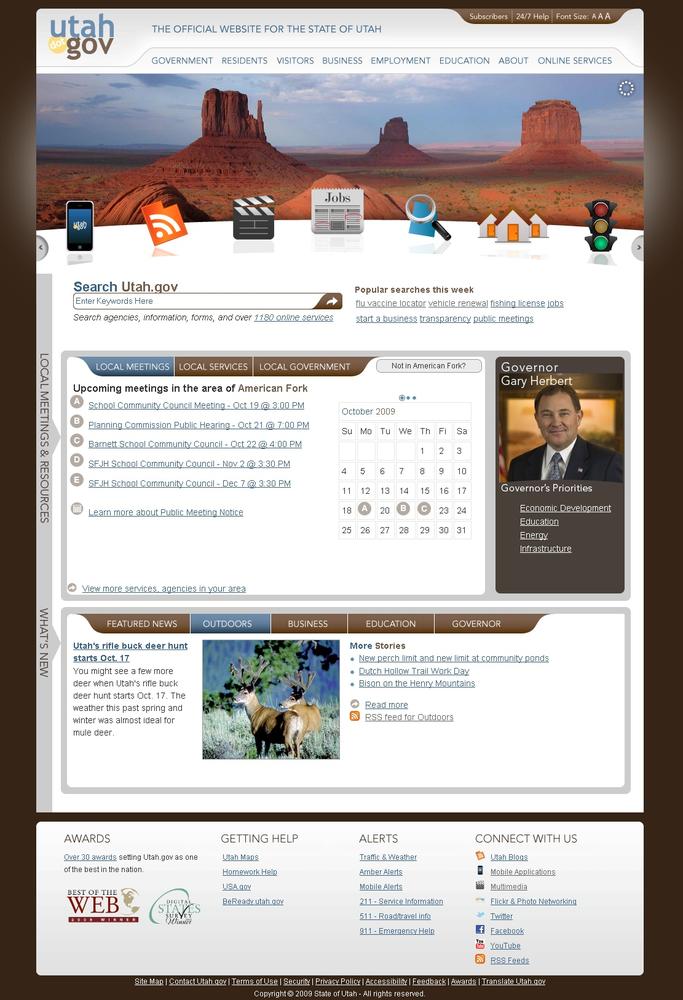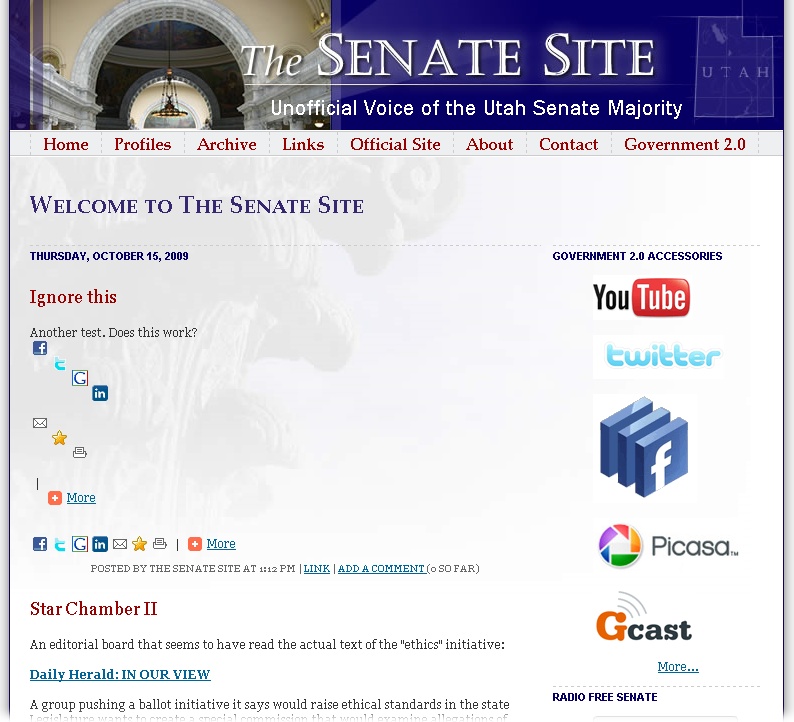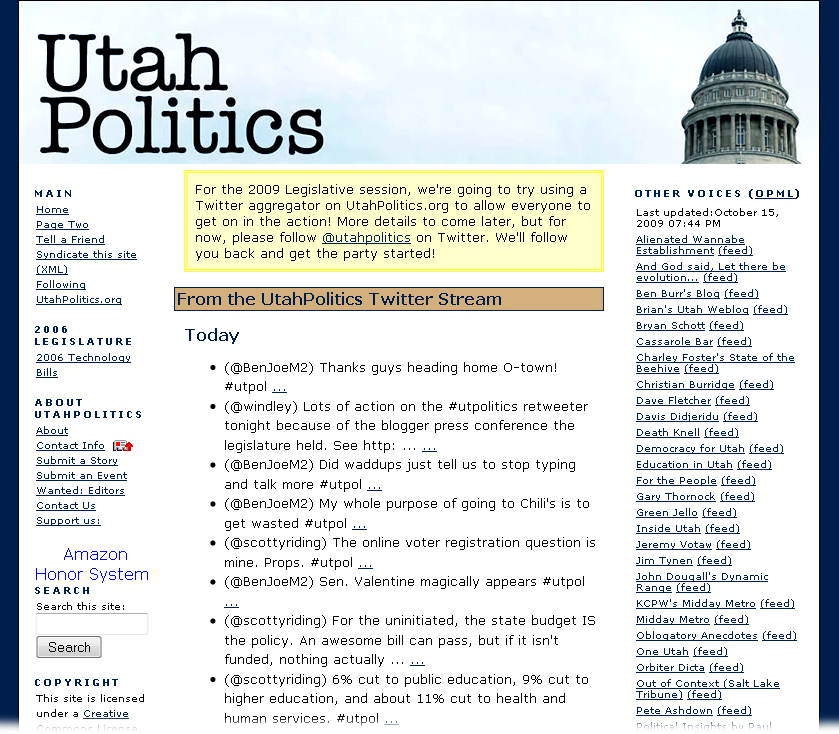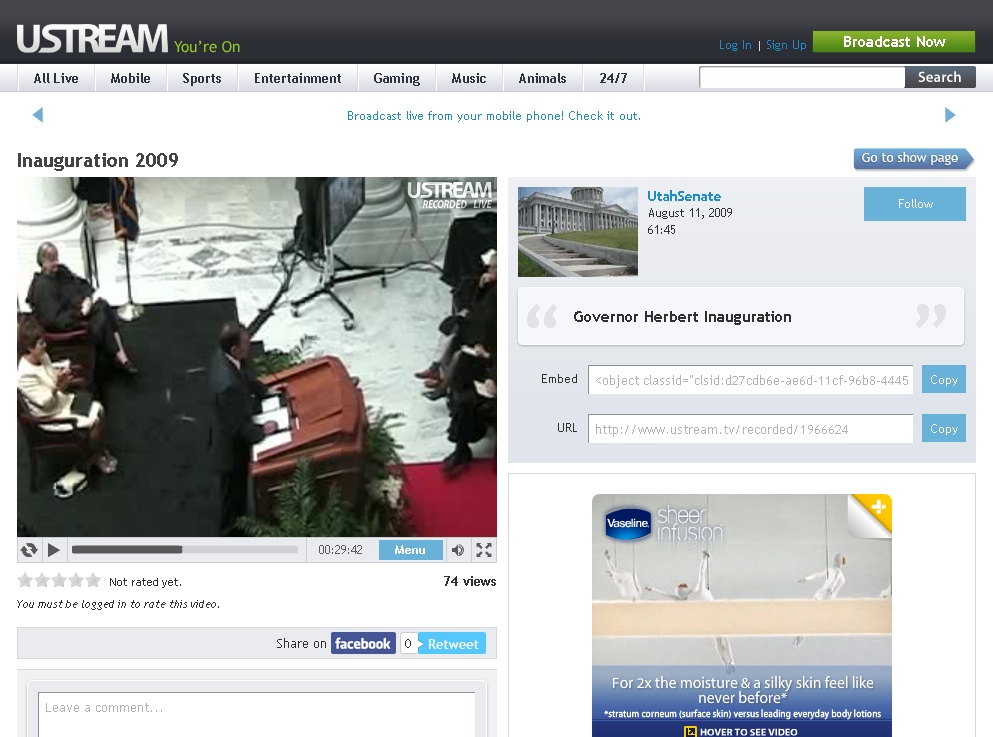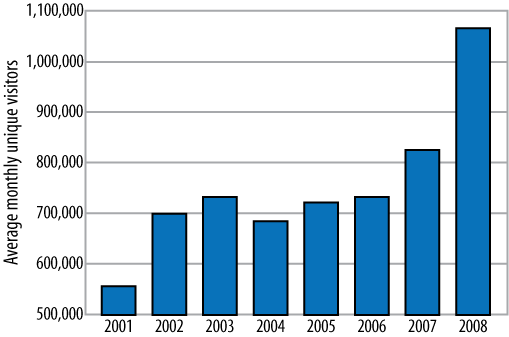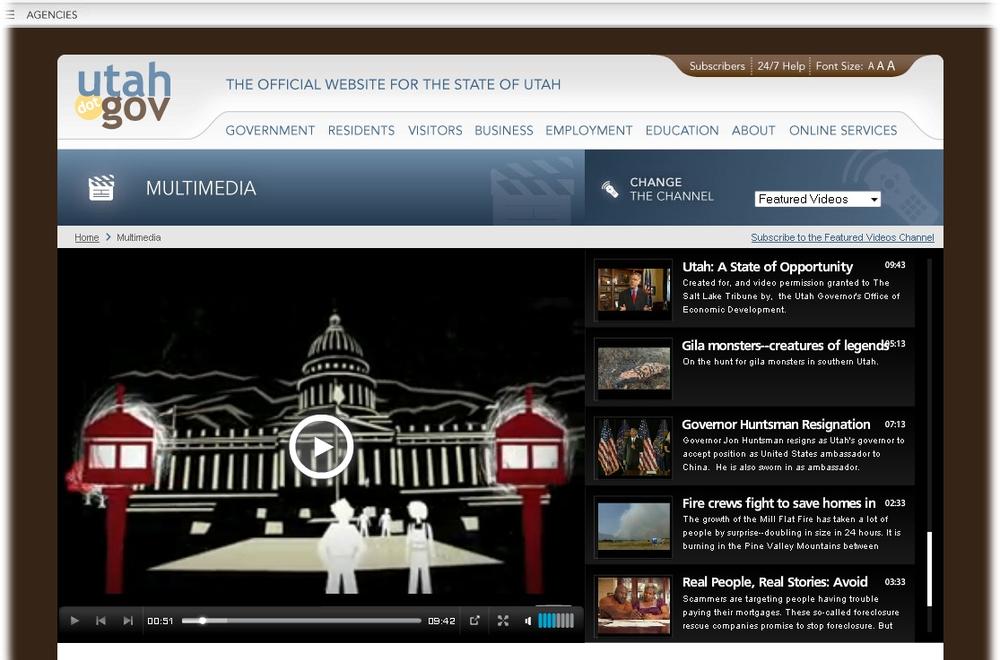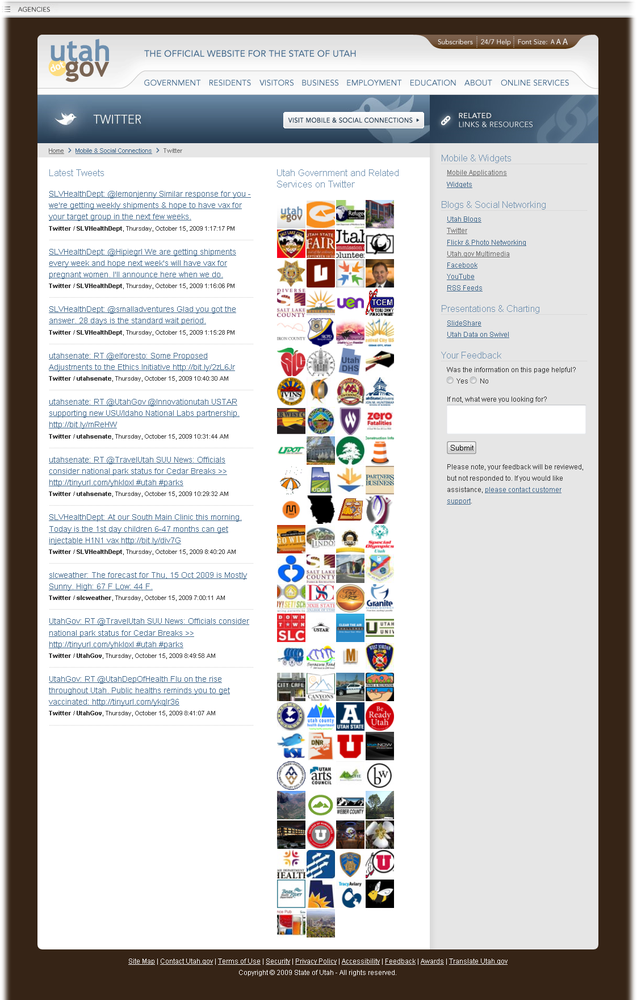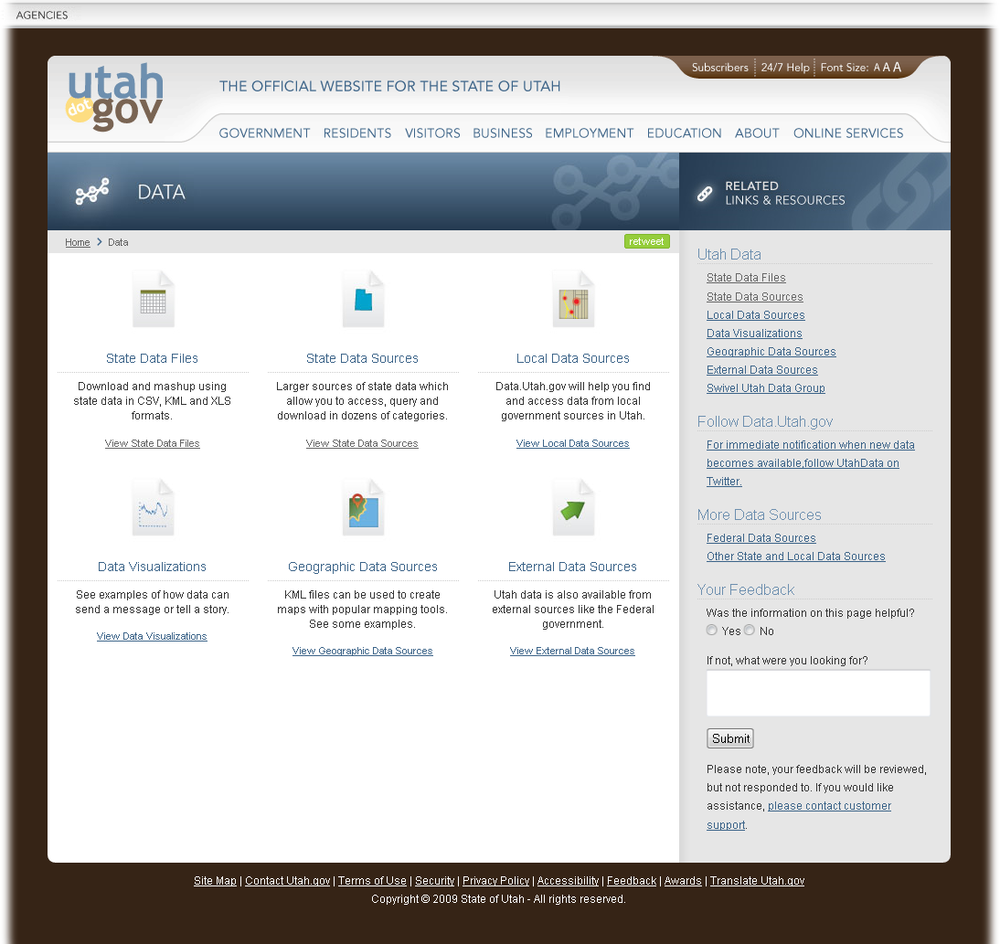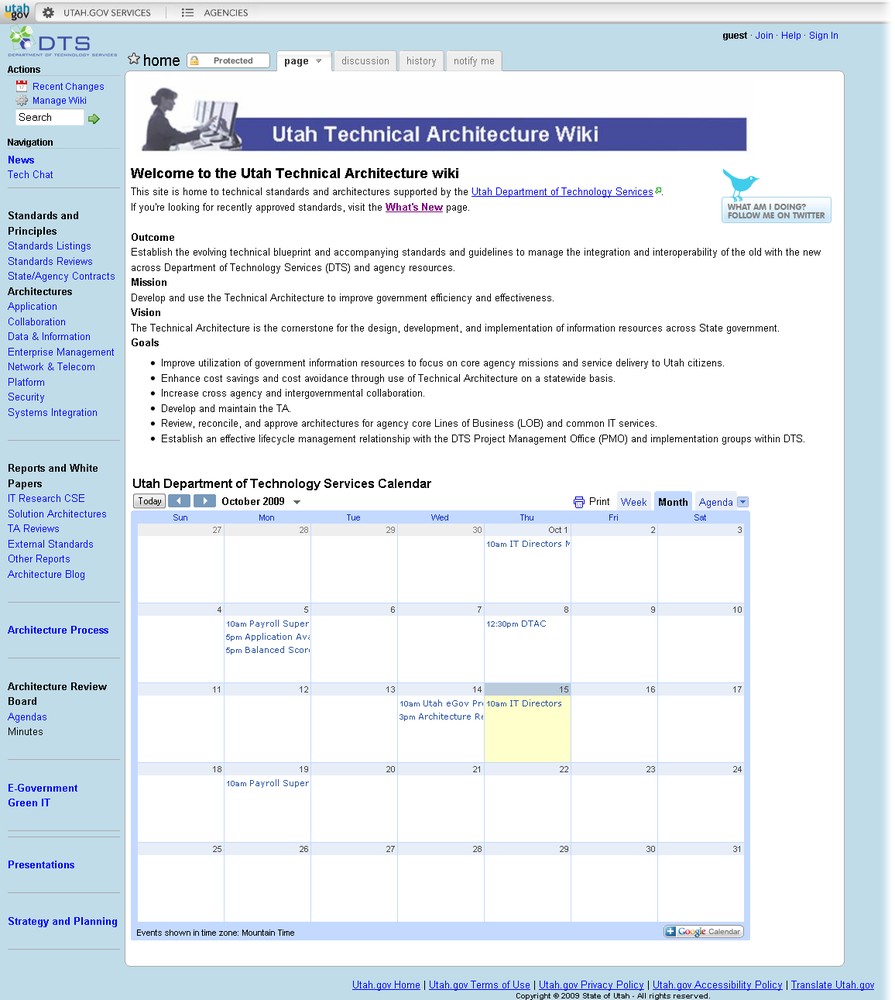Chapter 34. Case Study: Utah.gov
A Historical Perspective
Fifteen years ago, a group of Utah government leaders met in the basement of the state office building to listen to a presentation on how to use the Netscape browser. At that time, they had no idea that this new tool would completely change the nature of their work and in many cases even eliminate much of what they did and replace it with something dramatically different.
In 1993, Governor Mike Leavitt talked to state workers about an information highway. He stated, “I believe we are entering an exciting new era in society…our world is becoming an information ecosystem, and the ramifications are monumental. Futurists believe there will be a massive shift in the nature of work and that the impact of the information age may be as great as the societal changes that occurred during the industrial revolution” (http://www.governor.state.ut.us/governor/elhighwy.htm). He followed up on that vision with a challenge that included five basic parts:
In government, we must change the way we think. We must think of technology, think of new applications, and think of new ways of doing things.
We must use existing resources and find ways to reallocate them, rather than raise taxes.
We must “put the state of Utah at citizens’ fingertips.” (He issued the first call to deliver specific services, including driver’s license renewals, tax payments, and fishing license purchases, electronically.)
Agencies must make “enormous amounts” of information and data available to the public electronically.
Leaders must encourage a strong competitive environment among infrastructure providers.
Sixteen years later, this vision has been replaced with reality. Because of the confidence in a 24/7 government service infrastructure, Governor Jon Huntsman made a bold decision to move forward in testing a statewide four-day work week in August 2008. Seventeen thousand employees made this change basically overnight. Utah leads the nation in terms of online services and e-government adoption. In 2008, the state was recognized by the Center for Digital Government as the top digital state in the nation. Following dramatic revisions to the state’s website in 2009, Utah.gov was recognized as the best state portal by the Center as well (see Figure 34-1).
The Utah.gov portal, updated in June 2009, includes Web 2.0 services integration along with new functionality such as GeoIP/location-based services, multimedia, and a statewide data portal.
With millions of online transactions and hundreds of unique communications channels that extend Utah government into the public arena, the online channel is now the predominant channel. For many government workers, it is tightly integrated into every aspect of their daily regimen. Many are quickly evolving from communications that consisted primarily of telephone calls and email to a multifaceted and more interactive communication structure that includes text and instant messaging, online chat, Twitter, and other social media channels.
What Today’s Landscape Looks Like
Utah now provides more than 870 online services to citizens and businesses. Many of these are common services such as renewing driver’s licenses, purchasing a fishing license, and paying taxes. Over the years, the state has learned how to improve online service through citizen interaction. In 2003, it became the first state to implement a 24/7 online chat service, allowing citizens direct contact with service personnel when they have questions. The state also includes an optional feedback channel with most services and has received thousands of responses that have been useful in improving the quality of service.
This new era of openness did not come easy. In 1995, there was still a lot of concern about how the Internet would be used. Leaders in every branch of Utah government worried about how their employees would utilize this new phenomenon and how it would affect their productivity. Some agencies banned use of the Internet while they worked to understand how to use it.
When streaming media first became available, there were debates about how much access the public should have to legislative hearings and meetings and how it would affect open discussion among legislators. Today, that same legislature pushes for more openness each year. In 2007, it passed a new law creating a public meeting notice system that required information regarding all state and local government meetings to be posted in a statewide system where anyone could find it. A year later, it passed a bill requiring that all state financial records be made available online and then extended that requirement to local government (http://transparent.utah.gov). “Government transparency has become a reality in Utah,” said Lt. Governor Gary Herbert. “This site allows everyone to see where and how their tax dollars are being spent. This commitment to openness and transparency will strengthen our state management.” News media and others interested in government spending no longer need to make special requests to agencies; they can find every expenditure online. Utah’s cities, counties, school districts, transit districts, and so forth will be providing their finances online within the next two years, since the state legislature expanded the bill creating the system to all local governments within Utah.
Champions Discovered in All Branches of State Government
The movement to create a more open and responsive government using the Internet as a medium has been successful to a large degree because there have been champions in all branches of the state government that have supported it. Legislative leaders such as Steve Urquhart and John Dougall started blogging as a way to share their thoughts with constituents and receive valuable feedback.
In 2007, Rep. Urquhart launched Politicopia, a wiki with the goal of increasing citizen involvement in the political process. Into the second week, he announced:
One week into the experiment, Politicopia is working. Citizens are participating and citizens are being heard. Legislators are talking to me about things they’ve read on Politicopia. Because of input I received, I have changed a position I’ve held for years.
The Utah State Senate has also been very progressive in its adoption of new methods for involving the public. The Senate Majority introduced SenateSite.com, which leverages YouTube, Twitter, Facebook, Gcast, and blogging in various experiments to involve the public. The Senate has held online town hall meetings where citizens can interact with and ask questions of the senators in real time. These experiences have resulted in a continually evolving and increasingly open setting where the business of government is conducted (see Figure 34-2).
The Utah State Legislature meets in open session for six weeks each year beginning in January. During this short period, more than 600 bills are considered, many of which make significant changes to state law. At the same time, the Legislature must review and approve a multibillion-dollar budget that covers state government as well as public and higher education. The tools of Web 2.0 now make this process much more understandable and open to all interested parties and the public at large. These users can subscribe to custom RSS feeds of any bill and get notified in real time anytime there is a change in content or process. This capability along with the ability to provide direct feedback through multiple channels is a huge change to the entire scene.
Utah bloggers have been participating in the Utah openness debate. In the last legislative session (February 2009), Rep. Urquhart held a press conference specifically for bloggers where he introduced a new bill. We have also witnessed significant growth in blogger participation in traditional press conferences which has added to a diversity of coverage and opinion on public issues. The bloggers have brought a new perspective to the debate that is different and unique from the traditional media. Often they are more intent on expressing an opinion or viewpoint that is frequently representative of a community within the state.
The Utah judiciary has also been involved in accepting new media tools for sharing information. The Utah Supreme Court has sought ways to make the courts more efficient by adding online services, self-help resources, and multimedia to their website. Citizens and attorneys are able to subscribe to the latest court opinions with a simple-to-use RSS feed. Citizens can prepare for jury service by accessing the online Jury Room. Utah state courts even facilitate access to these services by providing free wireless access in many Utah courthouses.
To a significant degree, the growth in the number of Government 2.0 advocates within an organization correlates to the amount of success generated in areas related to the goals of digital government, social networking, and open government. As successful initiatives are completed, promoted, and recognized, others within the organization will see that success and naturally want to replicate it (see Figure 34-3).
Former Utah CIO Phil Windley now runs Utah Politics, a private sector site that aggregates blogs and microblogs discussing the Utah political scene.
The Dramatic Shift to Web 2.0 Principles and Tools
In Utah, the transition to a new level of openness embracing those concepts and tools identified as Web 2.0 has been about as dramatic as the initial move to embrace digital government in the 1990s. Many new relationships among government agencies and personnel begin on the Web as government workers identify new ways of getting work done and servicing constituents. For example, a recent statewide health conference session was successfully arranged entirely on Twitter by parties that had never met prior to the event. The collaboration involved five separate agencies and quickly came together in just a few hours.
In 2002, the state began managing its online presence as a product and e-government product managers were assigned in each agency. These managers, often high-level officials within the agency, were tasked with coordinating their efforts through a statewide “product management council.” Over the years, this council has become a think tank where the best ideas are shared and filtered to the top. New websites and concepts are shared every month in this statewide forum and the product managers return to their agencies with ideas about how to improve what they are doing online.
Many government events are streamed live, such as Governor Gary Herbert’s inauguration on U-Stream (see Figure 34-4).
As information technology (IT) assets were moved into a single organization in 2005, CIO Stephen Fletcher challenged that organization to become world-class in everything it did. To meet that challenge required an understanding of best practices, not just in government but also in business, and caused many employees to stretch as they sought to reach their potential. The Department of Technology Services is now the home agency for all of the state’s technology workers and has been consolidating data centers and other platforms while developing statewide standards to make IT more efficient. Through all of this transition, the number one priority has still been to ensure that agency business needs are met.
External Users Dictated Technology Course
Although Utah had developed a state IT plan for many years, this plan often tended to focus on traditional solutions and infrastructure. At the end of 2006, an e-government plan was created for the 2007–2009 period which emphasized specifically the goals and initiatives that would focus on delivering services and information to citizens and business. IT leaders regularly measured the growing trend in the use of online services and the website in general. During the two years from 2007 to 2008, average monthly use of the Utah.gov domain increased from about 700,000 unique visitors to more than 1 million. The demographics and technical capabilities of these users had also changed significantly from the early part of the decade, and by 2008, more than 95% of incoming users had access to broadband service. Utah’s web audience is also younger and more tech-savvy than what has been measured by some other government websites. These users were now expecting to find government services online as a matter of course, rather than as the exception. And they expected those services to be easy to use and more interactive. Utah’s efforts to create dynamic and visually appealing services also paid dividends, resulting in some of the highest adoption rates for online government services anywhere in the country (see Figure 34-5).
Web 2.0 Becomes Part of the Technical Architecture
The initial e-government plan included an entire section on government collaboration.
In June 2008, Utah Governor Jon Huntsman announced a new initiative which he called Working 4 Utah. More than 17,000 Utah government employees would move to a four-day work week, and the state planned to close about 400 government office buildings for the entire three-day weekend. The move was facilitated by the fact that a large number of critical services were now online. The change meant that citizens would have access to traditional services for an extended business day (7:00 a.m. to 6:00 p.m.) from Monday through Thursday, but would need to rely entirely on digital services on Friday. The transition to a 4/10 work week that occurred in 2008 was easier as a result of agencies’ efforts to put more services online. Utah had already evolved to a model where numerous services were provided on a 24/7 basis, and many citizens were already accustomed to receiving their services through the online channel. Many citizens became advocates of the new initiative in the social media debates that ensued following the decision, even to the extent of promoting the use of the state’s online services in the online chats and forums. Although the standard work week is still 40 hours long, more than 80% of employees prefer it to the previous model. When customers have questions about how to get something done on Fridays, more often than not the agency can refer them to online information and services. After an initial review, it was noted that lines at the DMV actually got shorter as people continued to migrate to the online service.
The Utah Architecture Review Board (ARB) approves technical standards that apply to all of the state’s executive branch agencies. Many agencies have been uncertain about how to utilize new social networking and other Web 2.0 tools and have been reluctant to move forward. The ARB passed a standard that identified best practice tools, reassuring agencies that these tools would not be blocked by state filters. This resulted in increased use by the agencies of tools such as Twitter and YouTube. Once agencies recognized that social media outreach and interactive online customer service using popular social media channels was officially sanctioned as a standard, the reluctance by employees to use these tools decreased.
Utah’s Multimedia Portal Leverages Web 2.0 Services
Today, because of their extensive use throughout Utah government, open environments have actually been incorporated into the Utah.gov portal with pages such as the Utah Multimedia portal and the Utah Connect page. The increased collaboration through Twitter has been phenomenal, evidenced through the Utah Twitter page that aggregates Twitter feeds from state and local government (see Figures 34-6 and 34-7).
Making Data More Accessible
After assessing gaps in what it offered online, in 2009 Utah introduced a groundbreaking new portal. Like others before it, the new portal introduced many new concepts and services into the pattern for how Utah does business online. Following the lead from Federal CIO Vivek Kundra, Utah was the first state government to create a state data portal with the goal of enhancing access to state-provided data. The data portal provides an aggregation point for users to access the data they are looking for.
There are links directly to XML, XLS, RSS, and other types of portable data as well as to sites that provide query capabilities to offer user-defined data sets and information. The intent of providing data on Data.utah.gov is to make it easier for users both in and out of government to purpose the data in productive ways that benefit the Utah economy as well as government itself. Many in Utah government support the effort to become a knowledge-driven, real-time enterprise. To reach this potential, Utah must be able to connect to its citizens and businesses, not only through social media channels but also semantically, through dynamic, real-time, data-driven connections. If government provides reliable, real-time data, third parties in government and in the private sector can provide new added value in all kinds of ways. The state created a Twitter account as a way to provide updates about the site and new data as it became available. After introducing the new site, the state began receiving calls from around the country about how to go about setting up a similar service, and the National Association of State CIOs (NASCIO) set up a working group to identify potential best practices and standards that it could share with its members. Initially, this group wanted to focus on concepts such as governance structures while Utah kept insisting on the need to keep things simple and “just do whatever you can.” Government tends to quickly rise to the level of bureaucracy when implementing projects that are viewed as enterprise in nature or as having a significant impact.
The new portal is an initial step toward what Tim O’Reilly calls “government as a platform” by providing data in formats that developers can use to create their own applications and mashups. It provides an organized view into government-collected data and is expected to grow over time. The data is categorized into six areas:
- State datafiles
These are raw datafiles in formats such as KML and CSV.
- State data sources
These are generally queryable sources of large amounts of data where the user can specify the data being searched for through widgets or queries.
- Local data sources
As local governments within the state continue to provide more data online, the state will provide an aggregation point to help find these sources.
- Data visualizations
These are examples of how state data can be visualized with maps, charts and graphs, and so forth.
- Geographic data sources
The state decided to create a separate category for geographic data because of the volume and uniqueness of the data available.
- External data sources
Many organizations, including the federal government, accumulate data from the state and then make it available online. Because the state wanted Data.utah.gov to be a one-stop center for locating Utah data, these sources are also included because of their relevance.
Sharing data is an important component in the state’s efforts to become more open. With increased emphasis and training, more government agencies are expected to provide data in KML, RSS, and other interoperable formats versus strictly downloadable formats such as CSV (see Figure 34-8).
Concerns About Security and Productivity
Most government entities that engage in Web 2.0-related activities quickly encounter the issues of security and privacy. In Utah, this is no different. Security personnel want to ensure that private data remains that way. One commonly held perspective is that systems outside the state’s control may have a tendency to be less secure because the state may not be able to verify what security measures that system or service may have in place. Utah conducts annual online security training which is required for all 23,000 state employees. This training also reinforces proper etiquette and security practices for online activities. The state has also implemented a technical architecture wiki where it shares information on technology standards and practices. Creating standards that address security and privacy concerns has helped Utah ensure that momentum is maintained in its digital government initiatives. Utah’s technical standards specifically authorize the use of a set of Internet-based collaboration tools that include services such as Twitter, YouTube, and SlideShare. The state recently approved social media guidelines to help employees avoid issues as they use these solutions (see Figure 34-9).
Conclusion
In 2006, when the state of Utah completed its previous statewide e-government strategic plan, it identified 50 ways in which state government could use the Internet to improve collaboration with businesses, with federal government, with citizens, and with education, as well as internally within state government. Those strategies included many of the things discussed here. As we complete the next strategic plan, projecting through 2012, collaboration and openness will become even more important, and Utah will continue to be among those states looking to leverage the next wave of technology and web-based services to meet the expectations of its citizens.
About the Author
David Fletcher serves as the chief technology officer in the Utah Department of Technology Services, where he has overall responsibility for e-government, innovation, and technical architecture for the State of Utah. During his tenure, Utah has been recognized as the top-performing digital state by the Center for Digital Government. David has also served the state of Utah as the director of general services, the director of information technology services, and the deputy director of the Department of Administrative Services. He has a master’s degree in public administration from the University of Washington, and he maintains a blog on the topic of technology in government.
Get Open Government now with the O’Reilly learning platform.
O’Reilly members experience books, live events, courses curated by job role, and more from O’Reilly and nearly 200 top publishers.
